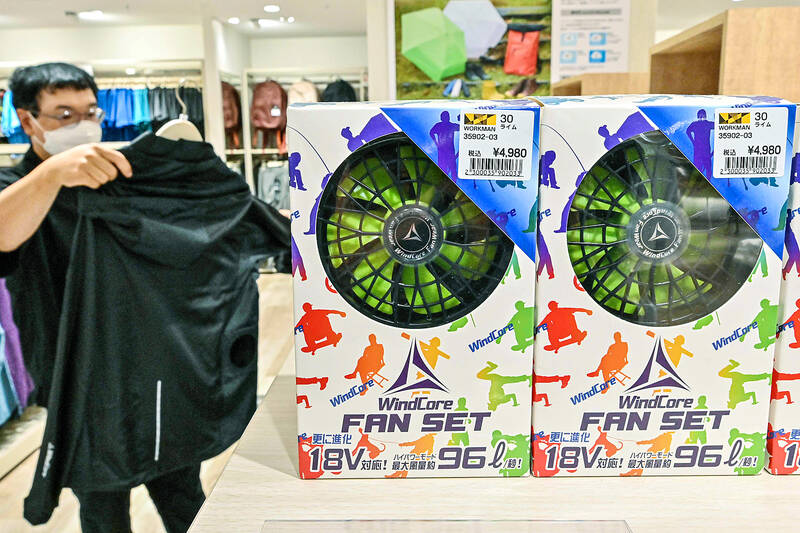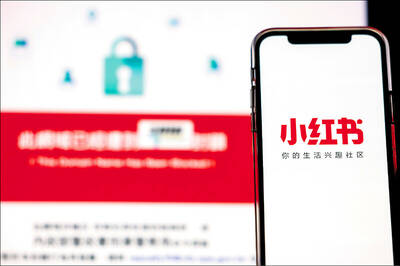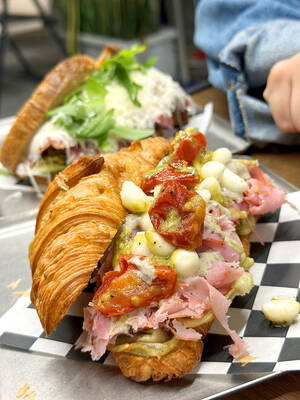Selling jackets with built-in fans, neck coolers and T-shirts that feel cold, Japanese firms are tapping into a growing market for products to help people handle the summer heat.
Japan — like other countries — is seeing ever-hotter summers. This July was the warmest in 100 years, with at least 53 people dying of heatstroke and almost 50,000 needing emergency medical attention.
Workman, which makes clothes for construction workers, launched a version of their fan-fitted jackets adapted for the high street in 2020 as demand grew.

Photo: AFP
The mechanism is simple — two electric, palm-sized fans powered by a rechargeable battery are fitted into the back of the jacket.
They draw in air to then deliver a breeze — at variable speeds — onto the wearer’s body.
The jackets retail for 12,000 to 24,000 yen (US$82-164).
“As the weather gets hotter, people who have never worn fan-equipped clothing before want to find ways to cool down... so more people are interested in buying it,” Workman spokesman Yuya Suzuki said.
“Just like you feel cool when you are at home with a fan, you feel cool just by wearing (the jacket) because the wind is blowing through your body all the time,” he said.
AGEING POPULATION AT RISK
Japanese summers are known to be hot and humid, but this July Tokyo really sweated.
The average temperature was 28.7 Celsius, the highest on record since 1875.
Heatstroke is particularly deadly in Japan, which has the second-oldest population in the world after Monaco.
More than 80 percent of heat-related deaths in the past five years have been among senior citizens.
“Some people die from heatstroke,” said Nozomi Takai of MI Creations, a company selling neck-cooling tubes mainly to factory and warehouse workers.
“Individuals as well as companies are putting more and more effort into measures against it every year,” Takai said.
The gel inside his firm’s brightly colored tubes — priced at 2,500 yen — is cool enough to use after 20 minutes in the fridge.
Wearing it on the neck will “considerably cool the whole body” for about an hour, she said.
Takai’s company joined an expo this year on “measures against extreme heat” in Tokyo to showcase new products that help users stay cool in the scorching heat.
At another booth, Tokyo-based company Liberta had a series of clothing including T-shirts and arm sleeves using prints that make users feel cool — especially when they sweat.
The prints use materials such as xylitol that feel cool when reacting with water and sweat, they said. Chikuma, an Osaka-based company, has even created office jackets and dresses equipped with electric fans.
“We developed them with the idea that it could be proposed in places where casual wear is not allowed,” Yosuke Yamanaka of Chikuma said.
Regular fan-fitted clothes can make the wearer look puffy, as they need to be zipped up, and cuffs are tight.
But jackets developed jointly by Chikuma, power tool maker Makita and textile giant Teijin do not need to be buttoned up, thanks to a special structure that sandwiches the fans in two layers and keeps the cool air in, Yamanaka said.
METRO-SEXUAL PARASOLS
Parasols, which are commonly associated in Japan with skin-tone-conscious women protecting against a summer tan, are now proving more popular with men too.
Komiyama Shoten, a small, luxury umbrella maker in Tokyo, began making parasols for men around 2019 after the environment ministry encouraged people to use them.
Before, many male customers thought parasols “were for women and they were embarrassed,” the owner Hiroyuki Komiya said.
“Once you use it, you can’t let go,” he added.
On the busy streets of popular tourist destination Asakusa, Kiyoshi Miya, 42, said he decided to “use his umbrella as a parasol.”
“It’s like I’m always in the shade and the wind feels cool,” he said.
Another visitor, Shoma Kawashima, wore a wearable fan around his neck to stay cool under the blazing sun.
“It’s so hot I want to be naked,” the 21-year-old said. Gadgets are helpful, but “not a solution” to rising temperatures, he added.

This month the government ordered a one-year block of Xiaohongshu (小紅書) or Rednote, a Chinese social media platform with more than 3 million users in Taiwan. The government pointed to widespread fraud activity on the platform, along with cybersecurity failures. Officials said that they had reached out to the company and asked it to change. However, they received no response. The pro-China parties, the Chinese Nationalist Party (KMT) and Taiwan People’s Party (TPP), immediately swung into action, denouncing the ban as an attack on free speech. This “free speech” claim was then echoed by the People’s Republic of China (PRC),

Exceptions to the rule are sometimes revealing. For a brief few years, there was an emerging ideological split between the Democratic Progressive Party (DPP) and Chinese Nationalist Party (KMT) that appeared to be pushing the DPP in a direction that would be considered more liberal, and the KMT more conservative. In the previous column, “The KMT-DPP’s bureaucrat-led developmental state” (Dec. 11, page 12), we examined how Taiwan’s democratic system developed, and how both the two main parties largely accepted a similar consensus on how Taiwan should be run domestically and did not split along the left-right lines more familiar in

Specialty sandwiches loaded with the contents of an entire charcuterie board, overflowing with sauces, creams and all manner of creative add-ons, is perhaps one of the biggest global food trends of this year. From London to New York, lines form down the block for mortadella, burrata, pistachio and more stuffed between slices of fresh sourdough, rye or focaccia. To try the trend in Taipei, Munchies Mafia is for sure the spot — could this be the best sandwich in town? Carlos from Spain and Sergio from Mexico opened this spot just seven months ago. The two met working in the

Many people in Taiwan first learned about universal basic income (UBI) — the idea that the government should provide regular, no-strings-attached payments to each citizen — in 2019. While seeking the Democratic nomination for the 2020 US presidential election, Andrew Yang, a politician of Taiwanese descent, said that, if elected, he’d institute a UBI of US$1,000 per month to “get the economic boot off of people’s throats, allowing them to lift their heads up, breathe, and get excited for the future.” His campaign petered out, but the concept of UBI hasn’t gone away. Throughout the industrialized world, there are fears that